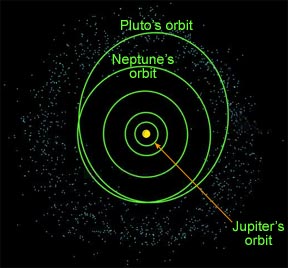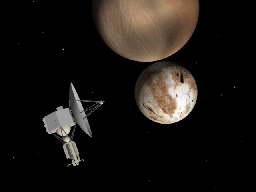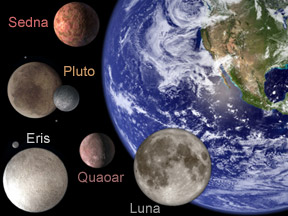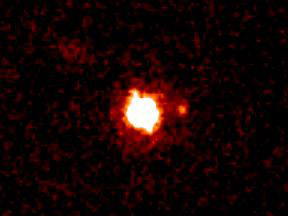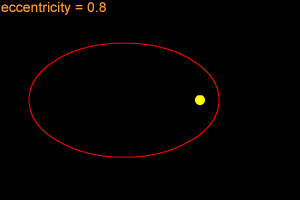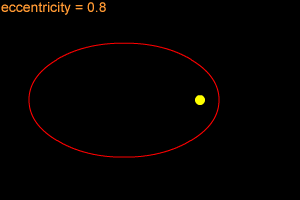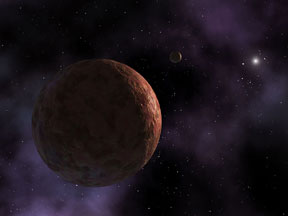Click on image for full size
Image courtesy NASA/JPL-Caltech.
The Kuiper Belt
The outer edge of our Solar System is not empty. There are many, many huge spheres of ice and rock out near Pluto's orbit. Astronomers call this huge group of planetoids "Kuiper Belt Objects", or "KBOs" for short. The Kuiper Belt is a bit like the asteroid belt, but much farther from the Sun.Scientists think there are many thousands of KBOs. Astronomers have discovered several hundred so far. KBOs are gigantic balls of ice and rock. Some are small, some are tens of km across, and some are as big as the planet Pluto, and maybe larger! They orbit the Sun on the edge of the Solar System, near Pluto. They orbit between 30 to 50 AU (1 AU = Earth to Sun distance) from the Sun. Some astronomers think the Kuiper Belt goes out to 100 AU. KBOs take 200 years or longer to orbit the Sun!
Some astronomers had a theory about the Kuiper Belt in the early 1900s. One of them was Gerard Kuiper. In 1951, Kuiper said that some kinds of comets might come from the Kuiper Belt. The Kuiper Belt was named after Gerard Kuiper. The first KBO was discovered in 1992. It was given the odd name "1992 QB1".
The planet Pluto is also a Kuiper Belt Object. There are probably a bunch of other KBOs as big as Pluto or bigger that we haven't found yet. This is why astronomers are having a hard time deciding what a planet is. Is Pluto a planet? Are any of the other KBOs? Astronomers have found one object, called 2003 UB313 for now, that looks like it is bigger than Pluto. Some people are calling it the "tenth planet".
There are a couple of different kinds of KBOs. The different kinds have different orbits. Some have orbits like Pluto's. They are called "plutinos" (mini-Plutos). Some have orbits that are more like circles. They are called "cubewanos".
There are other objects besides KBOs out on the edge of the Solar System. The Oort Cloud is much, much further out than the Kuiper Belt. All of the objects on the frozen edge of the Solar System can be put in one big group. Astronomers call that group "Trans-Neptunian Objects" (TNOs) because they orbit further from the Sun than Neptune. KBOs and objects in the Oort Cloud are all Trans-Neptunian Objects. So are some other odd misfits that are in-between the Kuiper Belt and the Oort Cloud, including Sedna and 2003 UB313.
Some of the best known KBOs are Pluto, 1992 QB1, Orcus, Quaoar, Ixion, and Varuna. Strange names for strange objects!


